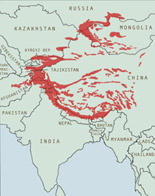The Afghanistan Government has just declared the country’s second national park, the entire Wakhan district in the remote northeast.
And like the first national park, Band-e Amir (designated in 2009) this one will also help protect the remaining endangered snow leopards in this country.
The Wakhan District, bordered by Pakistan to the south, China to the east, and Tajikistan to the north, has for centuries been a strategic area for the movement of many ethnic peoples and the centre of political intrigue. Today it still has huge wildlife diversity with snow leopard, wolves, red foxes, Marco Polo sheep, brown bears, lynx, Himalayan ibex and urial. Recently even the elusive Pallas cat was discovered here. LINK

A community of Kyrgyz herders with their domestic sheep and goats in Wakhan District, now a National Park. Photo Mathew Paley, Nat Geo.
I was extremely lucky to have been able to travel through this beautiful place in the late 1970’s, travelling by local buses where the Hindu Kuch and the Pamir Mountains meet. The hospitality of the people was extraordinary and the mountain scenery awe inspiring.
Today large communities of Wakhi people (over 13,000) still live side by side with small communities of ethnic Kyrgyz (1500 or so), all reliant on small scale vegetable farming and livestock rearing of domestic sheep, goats, horses and yaks, on which they rely for milk, cheese, meat and transport.
The Afghan government worked with the New York based Wildlife Conservation Society (WCS) in collaboration with local groups to forge partnerships resulting in the national park. Like many national parks in this part of the world, the traditional communities will continue to live in the area. They will follow traditional livelihoods while at the same benefiting from improved services and sustainable job opportunities like rangers and park managers. In time there may even be income generated from tourism as the region currently gets between 100-300 travellers a year.
Prince Mostapha Zaher, the director-general of Afghanistan’s National Environmental Protection Agency, called it “one of the last truly wild places on the planet.” He said his grandfather, King Zaher Shah, had first dreamed of creating a national park in the area in the 1950s.
“We can prove that the cause of protecting the environment and wildlife can also be utilized as an instrument of peace and tolerance,” said Zaher.
Dr Peter Zahler, WCS Asia Program Deputy Director, said: “We are delighted by this historic event. Wakhan National Park will protect over 70 percent of snow leopard habitat in Afghanistan, and it will bring desperately needed services to some of the poorest and most isolated people in the country. It also shows Afghanistan’s continued commitment to fulfilling its global obligations to protect its biodiversity and determination to move forward and realize a bright future for the country.

The harshness of winter. Traders battle snow bound narrow tracks in Wakhan distric to get from one community to another. Photo by Mathew Paley Nat Geo.
The Wakhan corridor, Dr Zahler says, is “extremely safe—as safe as any high-mountain area can be.” The region has not seen recent violence, the Taliban “has no interest in it,” and the people “are very welcoming. Still, that success may hinge on Afghanistan’s overall stability.”
Read more about snow leopard research and conservation in Afghanistan including the first radio collaring of wild snow leopards and the first camera photos of snow leopards in the Wakhan district.
Read about status of snow leopards in Afghanistan.






Comments on this entry are closed.